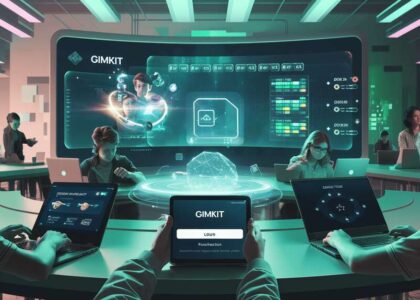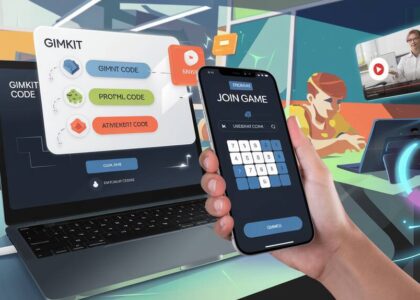In the dynamic world of educational technology, Gimkit stands out as a transformative tool, turning mundane quizzes into engaging, game-like experiences that captivate students and enhance learning. Designed by a high school student, Gimkit empowers educators to create interactive quizzes where players earn in-game currency by answering questions correctly, using those earnings to buy upgrades and compete. Its popularity has soared in classrooms worldwide, praised for its ability to make learning fun and competitive.
Yet, as with any online platform, the rise of gimkit hacks—unauthorized methods to manipulate the game—has sparked curiosity and concern. These gimkit hacks, ranging from auto-answer tools to money generators, promise shortcuts to success but threaten the integrity of this educational gem. This article dives deep into the phenomenon of gimkit hacks, exploring what they are, why they’re sought, the risks they pose, and how educators can prevent them, ensuring Gimkit remains a fair and effective learning tool.
Understanding Gimkit Hacks
Gimkit hacks represent a shadowy side of this educational platform, where players employ unauthorized techniques to gain unfair advantages. At their core, gimkit hacks are scripts, extensions, or tools that alter the game’s mechanics, allowing users to bypass its educational intent. Imagine a student activating an auto-answer bot during a Gimkit session: instead of wrestling with a history question about the Renaissance, the bot instantly supplies the correct answer, racking up points without any effort.
This is just one example of how gimkit hacks undermine learning. Other common hacks include money generators, which flood a player’s account with unearned in-game cash, and join hacks, which let unauthorized users crash a game session. These gimkit hacks exploit vulnerabilities in the game’s code, often through browser-based manipulations, turning a tool meant for education into a playground for cheating.
The appeal of gimkit hacks lies in their promise of effortless victory. For instance, a money generator might allow a student to buy every power-up available—doubling their earnings or freezing opponents—without answering a single question correctly.
Meanwhile, join hacks disrupt the game’s structure, letting outsiders infiltrate a private classroom session, throwing off the rhythm and focus. Such gimkit hacks don’t just affect individual players; they ripple through the game, skewing competition and diluting the educational experience. Understanding these hacks is the first step for educators and students to recognize their impact and take action against them, preserving Gimkit’s purpose.
Types of Gimkit Hacks
The variety of gimkit hacks reflects the creativity—and audacity—of those seeking to bend the rules. Auto-answer bots are among the most notorious, acting like a digital cheat sheet that solves questions in real-time. Picture a student sitting quietly as their screen flashes correct answers to biology questions about photosynthesis, all without lifting a finger.
These bots often rely on pre-programmed databases or screen-scraping technology, making them a formidable foe to fair play. Then there are money generators, a different breed of gimkit hack that floods accounts with virtual cash. In a typical Gimkit game, currency is earned through correct answers, but with this hack, a player could amass thousands of dollars instantly, buying upgrades that honest players can’t access.
Join hacks, though less about academic advantage, are equally disruptive. They allow players to slip into games uninvited, perhaps as a prank or to sabotage a session. Imagine a teacher’s carefully planned review game interrupted by an outsider spamming incorrect answers, confusing students and derailing the lesson.
Each type of gimkit hack targets a different aspect of the game—knowledge, resources, or access—but they all share a common goal: to sidestep the effort that Gimkit rewards. By exploring these types, we uncover the breadth of challenges educators face when tackling gimkit hacks in their classrooms.
How Gimkit Hacks Operate
The mechanics behind gimkit hacks are a blend of technical cunning and opportunism. Most operate by manipulating the game’s front-end code, which runs in a player’s web browser. For example, a gimkit hack like an auto-answer bot might use JavaScript to intercept quiz questions as they load, cross-referencing them with an external answer key or algorithm to submit responses instantly.
This process happens so fast that it mimics genuine play, making it tricky to spot without close scrutiny. Money generators, on the other hand, tweak the game’s variables—think of them as digital forgers, altering the number of dollars displayed on-screen to trick the system into granting unearned wealth.
Join hacks exploit authentication loopholes, bypassing the checks that ensure only invited players enter a game. These gimkit hacks often come as browser extensions or scripts downloaded from shady corners of the internet, requiring little expertise to deploy but a lot of nerve to use.
The ease of access to such tools amplifies their spread, with online forums and videos offering step-by-step guides—though we won’t delve into specifics here, as promoting how to hack gimkit contradicts the ethical stance of this article. Instead, understanding their operation equips educators to anticipate and counter these threats, keeping gimkit hacks at bay.
Must Visit: Gimkit Code: The Best Ways to Get Free Access in 2025
Why Students Pursue Gimkit Hacks
The quest for gimkit hacks isn’t just about technical trickery; it’s rooted in human impulses that educators must understand to address effectively. At its heart, the drive to use these hacks often stems from a craving for success without the grind.
Students might feel overwhelmed by academic pressure—say, a looming exam or a tough subject like algebra—and see gimkit hacks as a quick fix to shine in class. In a game where points and leaderboards fuel competition, the temptation to outpace peers with a gimkit hack can be irresistible, especially for those who equate scores with self-worth.
Curiosity also plays a role. Some students, tech-savvy and adventurous, view cracking Gimkit as a challenge, a puzzle to solve rather than a rule to break. Others might stumble across a video titled “how to hack gimkit” and experiment out of intrigue, not malice.
Then there’s the thrill of rebellion—using a gimkit hack to disrupt a game can feel like a harmless prank to a bored teenager, unaware of the broader consequences. These motivations reveal why gimkit hacks persist, offering insight into the mindset educators must engage to foster honest participation.
The Psychology of Cheating
Delving deeper, the psychology behind seeking gimkit hacks mirrors broader patterns of cheating in education. Studies, like those from the Josephson Institute, suggest that pressure to succeed often outweighs ethical qualms, with over 60% of students admitting to cheating at least once. In Gimkit, this translates to a student opting for a gimkit hack to avoid the embarrassment of a low score in front of classmates. The game’s competitive design amplifies this, as leaderboards spotlight winners and losers alike, pushing some to desperate measures.
Social dynamics also fuel the trend. If one student brags about a gimkit hacked session that earned them a top spot, others might follow suit, normalizing the behavior. This herd mentality can turn a single gimkit hack into a classroom epidemic, especially among teens eager to fit in. Yet, beneath these actions lies a paradox: the same students who use gimkit hacks to “win” often miss out on the skills—like critical thinking or resilience—that Gimkit aims to build, trading short-term gains for long-term losses.
Competition’s Double-Edged Sword
Gimkit’s gamified approach is a strength, but it’s also a vulnerability exploited by gimkit hacks. Competition motivates students to engage, turning a dry vocabulary quiz into a lively showdown. However, when winning becomes the sole focus, the educational mission blurs. A student might think, “Why study when I can learn how to hack gimkit and dominate?” This shift from learning to triumphing drives the demand for gimkit hacks, as the game’s rewards—currency, upgrades, bragging rights—overshadow its purpose.
Consider a real-world parallel: in sports, doping scandals erupt when athletes prioritize medals over integrity. Similarly, gimkit hacks are the digital doping of educational gaming, offering a shortcut that undermines fair play. Educators can counter this by reframing competition, emphasizing effort and growth over rankings, thus reducing the allure of gimkit hacks and realigning the game with its learning goals.
Must Visit: Gimkit Host Mastery to Easily Create Engaging Live Games
Risks and Consequences of Gimkit Hacks
The allure of gimkit hacks comes with a steep price, one that students and educators must weigh carefully. First and foremost, using these hacks breaches Gimkit’s terms of service, a digital contract players agree to upon signing up. The consequence? Account bans that lock users out of the platform, stripping them of access to a valuable learning tool. A student caught with a gimkit hack might find their account suspended mid-semester, disrupting their studies and leaving them to explain the lapse to teachers and parents.
Beyond bans, the risks escalate into darker territory. Many gimkit hacks require downloading scripts or extensions from unverified websites, opening the door to malware, viruses, or data theft. Picture a student installing a supposed “gimkit hack” only to have their personal information—passwords, emails, even school login details—harvested by cybercriminals. Ethically, gimkit hacks erode the learning process, cheating students of knowledge and fostering a mindset where shortcuts trump effort, a habit that could haunt them beyond the classroom.
Security Dangers Unveiled
The security threats tied to gimkit hacks are no small matter. Cybersecurity experts, like those at Norton, warn that unverified downloads are a prime vector for malware, with 1 in 10 websites hosting malicious content. A student hunting for “how to hack gimkit” might land on a site offering a free gimkit hack tool, only to install a Trojan that logs their keystrokes or hijacks their device. In a school setting, this could spiral into a network-wide breach, compromising sensitive data across dozens of users.
Real-world cases underscore this peril. In 2022, a phishing scam targeting educational platforms tricked students into downloading fake tools, resulting in stolen credentials and a district-wide lockdown of systems. Gimkit hacks, often sourced from similar shady corners of the web, carry the same risk, turning a quest for in-game glory into a cybersecurity nightmare. Educators must educate students about these dangers, framing gimkit hacks not just as cheating, but as a gamble with their digital safety.
Ethical Fallout in Education
Ethically, gimkit hacks strike at the heart of education’s mission. Learning is a journey of struggle and triumph, where mistakes teach as much as successes. When a student uses a gimkit hack to ace a game, they bypass this process, gaining points but losing insight. Over time, this hollows out their education, leaving gaps in knowledge that surface in exams or real-world challenges. Worse, it sets a precedent: if gimkit hacked wins feel good, why not cheat elsewhere?
The fallout extends to peers. Honest students, watching a classmate soar with gimkit hacks, might feel cheated or demoralized, questioning the point of their effort. This erodes trust in the classroom, turning a collaborative space into a battleground of suspicion. Educators must highlight this ethical cost, showing students that gimkit hacks don’t just cheat the game—they cheat themselves and their community.\
Must Visit: Gimkit Join Now: 7 Powerful Tips to Enter Games Fast
Preventing Gimkit Hacks in the Classroom
Educators aren’t powerless against gimkit hacks; they hold the key to detection and prevention, safeguarding the game’s integrity. Start with vigilance: monitoring student performance can reveal telltale signs of hacks. A student consistently scoring 100% in seconds or amassing absurd amounts of currency might be using a gimkit hack. Gimkit’s live game reports offer a window into this, detailing answers and timing for each player, making anomalies stand out like a sore thumb.
Prevention, though, is proactive. Randomizing questions—drawing from a large pool so no two players get the same set—thwarts auto-answer bots, forcing real engagement. Waiting rooms, where teachers approve entrants, block join hacks cold. Reporting suspected gimkit hacks to Gimkit’s support team also helps, as developers patch exploits swiftly when alerted. By blending these strategies, educators can keep gimkit hacks in check, ensuring a level playing field.
Detecting Hacks Through Observation
Detection hinges on keen observation and Gimkit’s built-in tools. In a live game, a teacher might notice a student finishing a 20-question set in under a minute, a feat implausible without a gimkit hack. The platform’s reports confirm this, showing perfect accuracy with no incorrect attempts—a red flag for auto-answer use. For assignments, where detailed logs are scant, completion times and accuracy rates still offer clues; a student breezing through complex material too fast warrants a closer look.
Anecdotes from educators illustrate this in action. Mrs. Carter, a middle school teacher, once spotted a student racking up millions in Gimkit cash during a review game. Digging into the report, she saw no wrong answers, just a steady climb in earnings—clear evidence of a money-generating gimkit hack. Confronted, the student admitted to testing a script “just for fun,” prompting a class discussion on fairness. Such stories show how detection doubles as a teaching moment, curbing gimkit hacks while reinforcing values.
Strategies to Thwart Gimkit Hacks
Preventing gimkit hacks requires a mix of tech savvy and classroom management. Randomizing questions is a game-changer; when each student faces a unique set, pre-programmed bots falter, unable to predict the sequence. Gimkit’s question bank feature makes this seamless, letting teachers craft diverse quizzes that keep hacks at bay. Access controls, like waiting rooms or passcodes, ensure only invited players join, slamming the door on gimkit hacked intrusions.
Education is the ultimate shield. Teachers can weave lessons on digital ethics into their curriculum, explaining how gimkit hacks harm learning and security. A workshop where students debate “how to hack gimkit” versus “why not to” can shift perspectives, turning potential cheaters into advocates for fair play. Pair this with regular updates from Gimkit’s team—patching vulnerabilities as they’re found—and the classroom becomes a fortress against gimkit hacks, preserving the game’s educational core.
Ethical Reflections on Gimkit Hacks
At its essence, Gimkit is about learning through play, a balance hacks disrupt. When a student uses a gimkit hack, they trade genuine achievement for a façade of success, missing the satisfaction of mastering a topic. Winning via effort—say, nailing a tricky science question after study—builds confidence and skills; winning via a gimkit hack builds nothing but a score. This ethical breach ripples outward, tainting the spirit of competition and the trust that binds a classroom.
Educators must champion integrity, showing students that the real victory lies in growth, not points. By framing gimkit hacks as a loss—not a gain—they can inspire honest engagement. After all, Gimkit’s brilliance isn’t in its leaderboards, but in its ability to make learning stick, a gift that no hack can replicate.
The Value of Honest Play
Honest play in Gimkit isn’t just a rule—it’s a principle with lasting rewards. When a student earns their way to the top, they gain more than a high score; they build resilience, knowledge, and pride. Contrast this with a gimkit hacked win: the thrill fades fast, leaving no trace of accomplishment. Research from the Educational Testing Service backs this, showing that students who engage authentically retain material longer than those who cheat.
Teachers can nurture this by celebrating effort over outcomes. A student who struggles but improves deserves praise as much as a natural high-scorer—perhaps more. When gimkit hacks tempt, reminding students of this deeper value can steer them back to integrity, ensuring the game serves its true purpose.
Building an Ethical Classroom Culture
An ethical classroom culture is the bedrock of resisting gimkit hacks. It starts with clear expectations: teachers must articulate why fairness matters, linking it to real-world success. Regular discussions—say, a monthly chat on gaming ethics—keep the topic alive, letting students voice pressures that might push them toward a gimkit hack. Pair this with positive reinforcement: spotlighting honest wins, even small ones, builds a norm where cheating feels out of place.
Consider Mr. Lopez, a high school teacher who faced a wave of gimkit hacks in his class. He turned it into a lesson, asking students to research “gimkit hacked” incidents and present findings on their impact. The exercise flipped the script—students became defenders of fairness, and hack use plummeted. Such initiatives show how culture trumps rules alone, rooting out gimkit hacks through shared values.
FAQs About Gimkit Hacks
1. What happens if someone uses a hack during a Gimkit live game I’m hosting?
If a hack is used, you might notice sudden leaderboard changes, like a player jumping to an unrealistic score. You can pause the game, review participant data, and remove the suspected user to maintain fairness.
2. Are there specific times when Gimkit is more vulnerable to hacking attempts?
While Gimkit’s security is consistent, hacking attempts might spike during high-traffic events like school tournaments or new feature releases, when more users are active and testing the system.
3. How can I spot fake websites offering Gimkit hacks?
Look for red flags like poor grammar, no official Gimkit branding, or requests for personal info. Legitimate Gimkit resources are hosted on their official site (gimkit.com) or verified platforms.
4. What motivates students to search for Gimkit hacks in the first place?
Students might feel pressured to excel, compete with peers, or bypass challenging material. Understanding this can help teachers address root causes rather than just the symptoms.
5. Can teachers customize Gimkit settings to make hacking harder?
Yes, using options like shorter game times, unique question sets, or enabling “KitCollab” mode (where students contribute questions) can disrupt common hacking patterns.
6. What’s the risk of joining a Gimkit game hosted by an unknown player?
Joining an unverified game could expose you to phishing attempts or malicious links disguised as hacks, potentially compromising your account or device.
7. How does Gimkit handle reports of hacking from multiple users in the same game?
Gimkit’s support team investigates patterns of reports, cross-referencing game data to identify and address widespread cheating attempts efficiently.
8. Are there browser extensions that claim to enhance Gimkit but actually hack it?
Some extensions marketed as “boosters” might alter game mechanics or steal data. Stick to trusted, well-reviewed tools and avoid anything promising unfair advantages.
9. How can I teach my students about the ethics of gaming without mentioning hacks directly?
Focus on broader concepts like integrity, fair competition, and the value of effort, using examples from sports or teamwork to subtly discourage cheating.
10. What should I do if I accidentally download a Gimkit hack?
Delete the file immediately, run an antivirus scan, and change your Gimkit password to minimize risks to your device and account.
11. Does Gimkit notify users if their account is targeted by a hacking attempt?
While Gimkit may not send direct alerts, suspicious login attempts might trigger security prompts (e.g., re-authentication) if extra protections are enabled.
12. Can hacking Gimkit games affect other classroom tools linked to my account?
If your Gimkit login is tied to a single sign-on system (like Google Classroom), a breach could potentially ripple to other tools, making strong passwords critical.
13. How can I test my Gimkit game for vulnerabilities before assigning it?
Run a trial session with colleagues or a small group, monitoring for odd behavior like score spikes, to ensure settings deter cheating.
14. Are there myths about Gimkit hacks that students commonly believe?
Some think hacks are undetectable or risk-free, but in reality, Gimkit’s monitoring systems catch most attempts, and consequences can include bans or school discipline.
15. What role does peer pressure play in the spread of Gimkit hacks among students?
Peers might share hacks to seem “cool” or help friends, amplifying their use. Encouraging a supportive, low-pressure classroom can reduce this trend.
These FAQs provide practical advice and insights tailored to real-world curiosities, ensuring they’re valuable for anyone navigating the topic of Gimkit hacks.
Conclusion
Gimkit hacks may glitter with the promise of easy wins, but their shine masks a host of perils—bans, security breaches, and a hollowed-out education. This article has peeled back their layers, revealing what gimkit hacks are, why students chase them, and how they threaten learning’s core. More importantly, it’s armed educators with tools to fight back, from detection tricks to prevention tactics, all grounded in an ethical stance that prizes integrity over shortcuts.
As Gimkit continues to evolve, so must our commitment to its mission: a fair, fun space where students grow through effort, not deceit. Let’s keep gimkit hacks in the shadows, where they belong, and let honest play light the way forward.
For quick access and the latest updates, visit Gimkit.it.com and enhance your Gimkit experience today!





